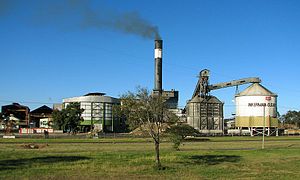**Sugar Production Process:**
– Harvest and transport to the sugar factory:
– Quality factors: agricultural practices, cultivar
– Harvesting methods: machine vs. manual
– Transportation methods: truck, railway, container, cart
– Cane sale based on weight or sugar content
– Importance of minimizing time between cutting and milling
– Juice extraction:
– Preparation of cane before extraction
– Modern processes: tandem mills and diffusion
– Products: mixed juice, diffuser juice, bagasse
– Comparison of traditional mill and diffuser
– Tandem mills operation and efficiency techniques
– Purification of the juice:
– Adjusting pH with calcium hydroxide
– Flash evaporation and impurities precipitation
– Clarification tank for sedimentation
– Filtration for further purification
– Recycling poor clarity juice
– Evaporation of water:
– Concentration of juice
– Multiple-effect evaporator usage
– Regulation of temperature, velocity, retention time
– Prevention of sucrose inversion, scale formation
– Crystallization:
– Vacuum boiling pan, crystallizer
– Evaporation for supersaturation
– Addition of seed grain, syrup in process
**Sugar Processing Techniques:**
– Evaporation and Crystallization:
– Water evaporation for crystal formation
– Massecuite formation and cooling
– Continuous crystallizer operation
– Centrifuging:
– Separation of crystals from molasses
– Operation at high speeds
– Purging after extraction
– Boiling System:
– Three-boiling system
– Different sugar grades in A, B, C stages
– Importance of crystallizers
– Efficiency of continuous vacuum pans
– Storage of Sugar and Molasses:
– Impact of bulk storage on sugar quality
– Direct packing of raw sugar
– Production of Plantation White Sugar:
– Quality standards for plantation white sugar
– Methods: carbonation and sulphitation
– Changes in purification, evaporation, storage
– Cost-effectiveness of sulphitation
– Making Plantation White Sugar:
– Carbonation and sulphitation processes
– Specific steps and materials used
– Storage of Plantation White Sugar:
– Vulnerability to color changes
– Countermeasures for discoloration
**Energy and Automation in Sugar Mills:**
– Energy in the sugar mill:
– Use of bagasse in steam boilers
– High-pressure steam for electricity
– Surplus bagasse utilization
– Factory automation:
– Adoption of automation in refineries
– Central process control system
– Decentralized PLCs for specialized machines
– Enhancements in control, security, efficiency
**History and Evolution of Sugar Mills:**
– Historical background:
– Origins in Arab Egypt
– Transition from trapiche to engenho
– Evolution in the Caribbean
– Types of mills:
– Utilization of wind, water, steam, animal power
– Structural components and power sources
– Modern adaptations:
– Technological advancements over time
**Additional Resources and References:**
– Trapiche, sugar refinery, Fiji sugar mills
– List of sugar mills in Queensland
– Citations, historical texts, modern research
– Books, journals, publications on sugar industry
– External links for further information
A sugar cane mill is a factory that processes sugar cane to produce raw sugar or plantation white sugar. Some sugar mills are situated next to a back-end refinery, that turns raw sugar into (refined) white sugar.


The term is also used to refer to the equipment that crushes the sticks of sugar cane to extract the juice.
